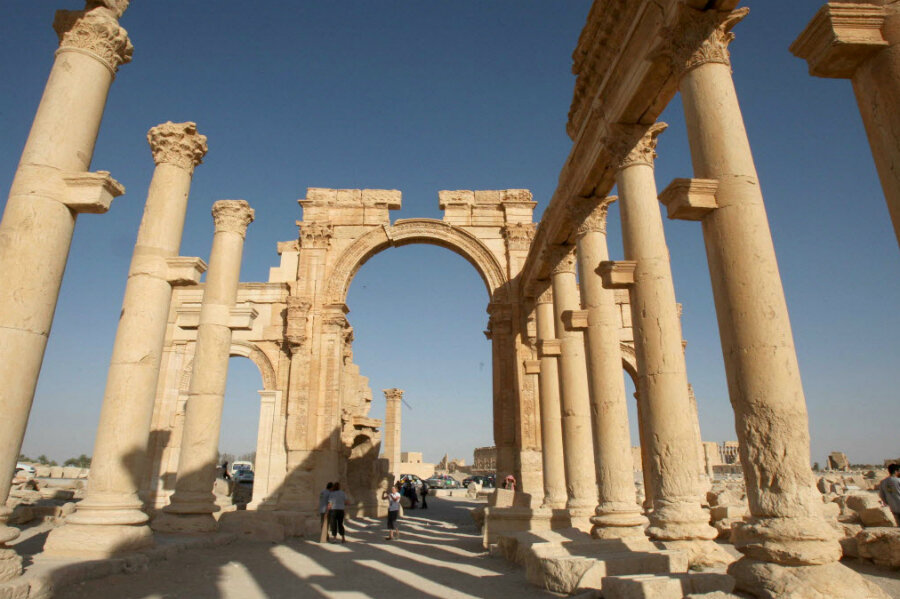Islamic State takes over ancient Syrian cultural site. Destruction ahead?
Loading...
As Islamic State militants extend and tighten their grip on growing portions of Iraq and Syria, they’re targeting not only cities, villages, and the forces opposing them but historical and cultural treasures dating back to King Solomon, ancient Persia, and Greco-Roman times.
On Thursday, that included the ancient Syrian city of Palmyra, where government forces were sent scurrying back toward Damascus and yet more Syrian refugees were forced to flee. Beyond the human tragedy is the potential for destruction in what UNESCO calls “one of the most important cultural centers of the ancient world … testament to the unique aesthetic achievement of a wealthy caravan oasis.”
“I am deeply concerned by the situation at the site of Palmyra,” Irina Bokova, director-general of UNESCO, said in a statement. “The fighting is putting at risk one of the most significant sites in the Middle East, and its civilian population.”
ISIS control of Palmyra has sent shockwaves through the archaeological community, says Carol Meyers, professor emeritus of religion at Duke University in Durham, N.C.
"At risk are the magnificent structures visible above ground and also the untold numbers of invaluable artifacts that lie unexcavated beneath the surface, ripe for plucking by plunderers who would sell them to fund ISIS operations,” she warns.
"The city goes back to biblical times, and it is mentioned in the Bible as a site fortified by King Solomon. Its prominence as a desert oasis meant that by Greco-Roman times, it became in important part of the east-west trade route of the ancient world,” Professor Meyers said, in a statement, Thursday. "Its interaction with the major powers of that time are evident in its material remains, which show a successful blending of Semitic, Roman and Persian cultures."
The Islamic State has been increasing its hold on large portions of Iraq and Syria. The Sunni extremist group has been campaigning to purge ancient relics they say promote idolatry that violates their fundamentalist interpretation of Islamic law. A video released in March shows them smashing artifacts in the Mosul museum. In January, the group burned hundreds of books from the Mosul library and Mosul University, including many rare manuscripts.
UNESCO recently condemned the bulldozing of cultural sites in Nimrud, Iraq – the biblical city of Kalhu in Nineveh province – a city founded more than 3,300 years ago as one of the capitals of the Assyrian Empire and known for its frescoes.
“This is yet another attack against the Iraqi people, reminding us that nothing is safe from the cultural cleansing underway in the country,” UNESCO Director General Bokova said then. “The deliberate destruction of cultural heritage constitutes a war crime.”
“They are not destroying our present life, or only taking the villages, churches, and homes, or erasing our future – they want to erase our culture, past and civilization,” Habib Afram, the president of the Syriac League of Lebanon, told the Guardian newspaper, adding that Islamic State actions were reminiscent of the Mongol invasion of the Middle East.
Some officials estimate that ISIS derives income from the sale of more than $200 million a year in looted antiquities, Monitor correspondent Jane Arraf reported from Irbil, Iraq, last November. Interpol and antiquities authorities have been taking steps to halt a lucrative trade in the smuggled artifacts of these ancient civilizations.
To some observers, Islamic State destruction and looting of cultural sites is reminiscent of the murderous Khmer Rouge regime in Cambodia in the 1970s.
“Both groups subscribe to the destruction of a collective memory in place of a favored revisionist other,” writes Elliot Brennan, a research fellow with the Institute for Security and Development Policy's Asia Program in Sweden. “In effect, both are anti-progress. Reminiscent of the Khmer Rouge’s ‘Year Zero’ concept is the recent footage of ISIS destroying ancient artifacts in Mosul and Nimrud.”
ISIS’s actions are part of a long history of people destroying ancient sites for political, economic, or religious purposes, says archeologist Amy Gazin-Schwartz, associate professor of anthropology at Assumption College in Worcester, Mass.
“The Assyrians looted and destroyed Babylon in 700 B.C.; medieval Christians in England toppled and broke up some of the ancient ‘pagan’ standing stones at Avebury; Spanish conquistadors melted down gold artifacts, including the solid gold ‘gardens,’ of the Inca,” Dr. Gazin-Schwartz writes in The New Republic. “Modern conflict has not respected antiquities. The 5,000-year-old cities of Ur and Uruk were heavily damaged by the first and second Gulf Wars.”
In March, more than 60 Iraqi cultural treasures illegally smuggled into the United States were returned to the Republic of Iraq, according to the US Immigration and Customs Enforcement.
In Damascus, Maamoun Abdulkarim, the head of the Antiquities and Museum Department, said Palmyra's town museum had suffered "minor damages" during the ISIS onslaught.
"The city is now totally controlled by gunmen and its destiny is dark and dim," warned Mr. Abdulkarim, according to the AP. "We are in a state of anticipation and fear" about what will happen to "the archaeological site and the remaining artifacts in the museum."
Abdulkarim told AFP that hundreds of statues and artifacts from Palmyra's museum had been transferred out of the city but many others – including massive tombs – could not be moved.
According to the latest reports, Islamic State fighters had entered Palmyra’s historical sites by early Thursday but there were no immediate reports of destruction.






